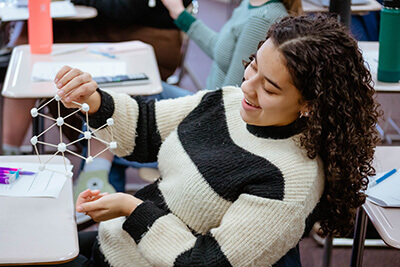April 4, 2024

from Jennifer Rogers-Petitt, director of development and community engagement
Editor’s Note: Periodically, you will find a guest Head’s Message here from members of the administrative team. We hope you will enjoy reading their thoughts and reflections about life at MPA.
From an early age, I loved stories. I would make them up for myself at playtime. When I began to devour them in books, I couldn’t put them down, and when I started to write down the fantastical comings and goings of my active mind, I never wanted to stop. As I’ve gotten older, had children, and experienced the highs and lows that life offers, I’ve continued to go back to the stories that have opened my eyes, inspired my heart, and made me think. As a fundraiser, I witness the power of our personal and collective stories every day when:
- I hear from an alum that their appreciation for MPA grows the more they experience in life;
- I hear from parents about their journey to MPA and their hopes and dreams for what it can offer their children; and
- I hear the joys and wishes of our faculty and staff as we dream about continuing to do right by our mission and the children in our care.
When I first came to MPA, my own story unfolded: someone not from Minnesota who had never experienced the independent school world and a fundraiser who had always wanted to be thoughtful about how I approached my work. Throughout my career, I have witnessed that if we dream big, tell stories, and stay true to our mission, we will once again spark the beautiful generosity of our community. I’ve now had six years of seeing that generosity come to life at MPA in so many ways: our incredible Family Commons and Martin Lenz Harrison Library, new tools and technology for students, a renovated outdoor track, new scholarship opportunities, COVID crisis funding, underwriting our diversity equity and inclusion initiatives, an innovation fund for teachers, and now, the Center for Inclusive Teaching & Learning. Throughout it all, I have talked with hundreds of community supporters and heard and shared stories of our collective impact through these funds.
When I thought about this guest article, I wanted to go back to storytelling in a vulnerable and transparent way to share why I am excited, nervous, and hopeful about undertaking a project like the Center for Inclusive Teaching & Learning. I first heard the term neurodiversity an embarrassingly short time ago, just after my divorce, while speaking to a therapist who was supporting my children as we navigated this massive change in our lives. This experience sparked my curiosity, and I began having conversations with my sister, a licensed therapist practicing in the small town where we both grew up. She opened my eyes to this incredible branch of neuroscience, psychology, and humanity. I wanted to learn more for myself and my kids and to better understand the world around me.
Neurodiversity describes the idea that people experience and interact with the world around them in many different ways; there is no one “right” way of thinking, learning, and behaving, and differences are not viewed as deficits. It is a framework for understanding our brains and behaviors. It is also often used as a proxy for a wide variety of specific diagnoses such as autism, ADHD, and dyslexia. While still underdiagnosed across the country, estimates are that 20% of the population has neurodivergence. When we consider mental health diagnoses such as anxiety and depression—particularly as a growing concern for adolescents—this number is even higher. In my family of seven, we hold to this norm: two of our children have been assessed and diagnosed as neurodivergent.
As we’ve learned more about neurodiversity and its connection to teaching and learning, my colleagues have shared with me this remarkable fact: strategies and teaching practices that support students who are neurodivergent have been shown to help all students. Some of these strategies include establishing clear routines, using visual aids and supportive technology, prioritizing hands-on learning activities, promoting social and emotional learning strategies, focusing on executive functioning skills such as organization and time management. Schools across the country, including colleges and universities, are implementing these practices with an eye toward inclusion and celebrating the unique strengths of every learner. MPA is proud to be a part of this growing movement.
We aim to support educators, families, and our community with students at the heart of this work. The Center for Inclusive Teaching & Learning embodies what we do best—individualized, whole-child educational experiences for all students—and empowers us to do it even better. This “Center” isn’t a new wing or building but rather the culmination of a desire by teachers and staff at every division and grade level for each student to thrive at MPA. It is about the people, tools, and resources needed to meet our mission for every student. Key elements we need help to fund include:
- Hiring an instructional coach and advocate to support teachers in meeting students’ needs.
- Professional development for teachers at all divisions and grade levels.
- New classroom furniture and design.
- Additional tools and services for students.
- Caregiver education and resources.
We have a need and desire to do better, and I am confident that, as a community, we will reach our goal to make the Center for Inclusive Teaching & Learning possible. I welcome the opportunity to discuss this project with you as a parent, potential supporter, or someone who wants to share their story or learn more about mine. Ways you can help support the Center:
- Attend this year’s Spring Auction on April 19 and raise your paddle to support the initiative.
- Schedule a meeting with me to learn more.
- Make a gift or pledge today that is right for you and your family.
Learn more about the Center for Inclusive Teaching & Learning by clicking here.